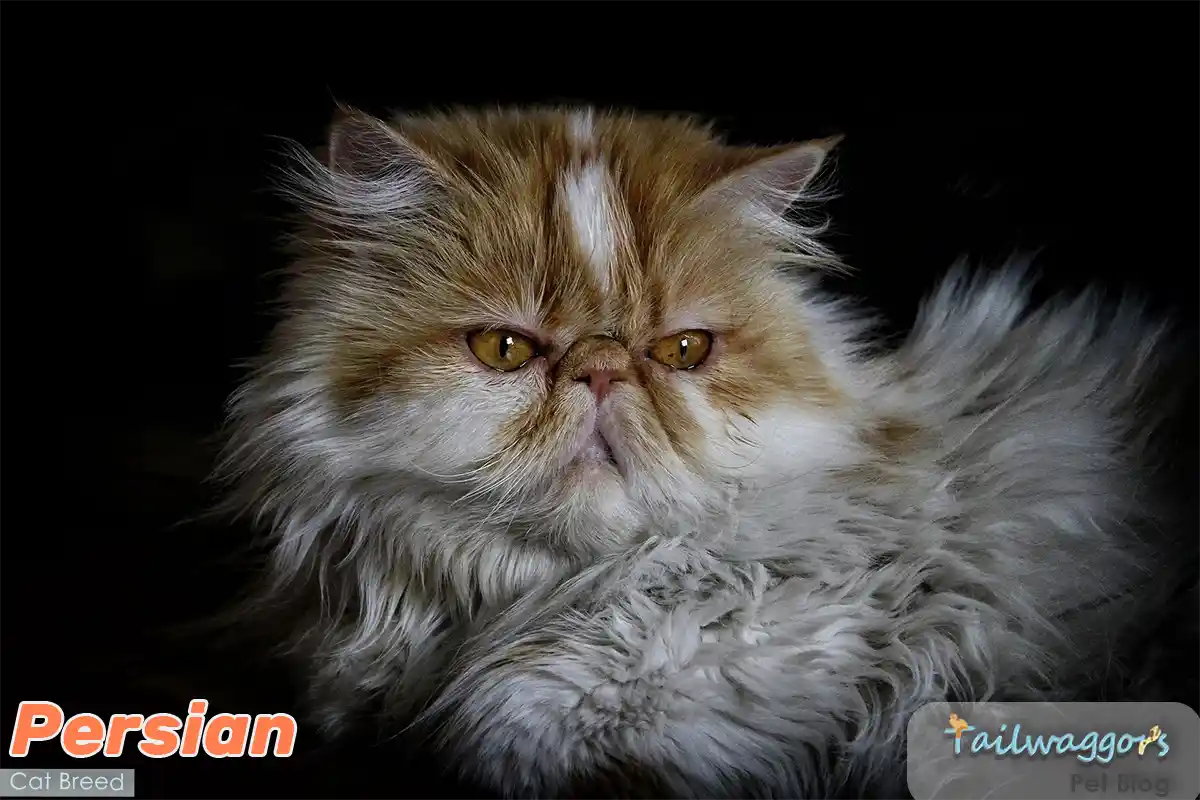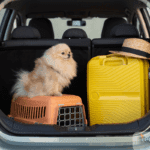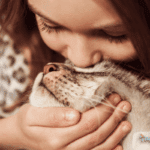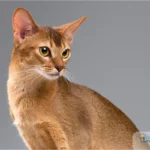Persian Cats: Living Works of Art
Persian cats are often called “living works of art” for good reason. These long-haired, flat-faced cats are not only one of the most visually striking breeds but also possess a serene temperament that makes them exceptional companions. Imagine a feline with a flowing, silky coat, large expressive eyes, and an air of regal elegance—this is the Persian cat. With their iconic appearance, luxurious fur, and tranquil personalities, Persian cats are among the most sought-after and cherished breeds worldwide.
But it’s not just their stunning appearance that draws people to this breed. Persian cats are known for being affectionate, gentle, and adaptable, making them perfect for families, singles, or seniors. Their calm demeanor and loving nature have earned them a reputation as one of the best companion cat breeds. If you’re looking for a calm, affectionate, and low-energy feline companion, a Persian cat might be the ideal match for your lifestyle.
Quick Facts: Meet the Persian Cat
Here’s a quick overview of the key characteristics of Persian cats, so you can get to know them even better:
| Characteristic | Description | Rating |
| Size | Males: 10–14 lbs (4.5–6.3 kg), Females: 8–12 lbs (3.6–5.4 kg) | ⭐⭐⭐ |
| Average Lifespan | 12–15 years | ⭐⭐⭐⭐ |
| Intelligence Ranking | Moderate | ⭐⭐⭐ |
| Exercise Requirements | Low to Moderate | ⭐⭐⭐ |
| Grooming Needs | Daily brushing and maintenance | ⭐⭐⭐⭐⭐ |
| Training Adaptability | Low | ⭐⭐ |
| Compatibility with Children | Excellent | ⭐⭐⭐⭐ |
| Energy Level | Low to Moderate | ⭐⭐⭐ |
| Shedding Level | High | ⭐⭐⭐⭐ |
| Apartment Living | Highly suitable | ⭐⭐⭐⭐⭐ |
| Health Issues | Brachycephalic respiratory issues, PKD | ⭐⭐⭐ |
| Cost of Ownership | High initial and maintenance cost | ⭐⭐⭐⭐ |
| Vocal Tendency | Quiet to moderately vocal | ⭐⭐⭐ |
| Social Needs | High | ⭐⭐⭐⭐ |
- • Perfectly suited for calm and loving households.
- • Known for their luxurious coats and serene temperament.
- • A great choice for families or individuals who enjoy a laid-back companion.
- • Require consistent grooming and health checkups due to their unique physical traits.
Key Traits of Persian Cats
- Regal and Elegant: Persian cats are admired for their iconic flat faces, large expressive eyes, and flowing, silky coats, which exude an air of sophistication.
- Calm and Affectionate: Known for their tranquil demeanor, Persian cats are gentle and loving, making them perfect lap companions for individuals and families alike.
- Low-Energy Companions: Persians are not overly active and prefer a laid-back lifestyle, thriving in serene environments where they can relax and bond with their humans.
- Social Yet Independent: While they enjoy the company of their owners, Persian cats are not overly demanding of attention, making them a balanced choice for various households.
- High Grooming Needs: Their luxurious coats require regular brushing to prevent matting, and their flat faces necessitate diligent cleaning to maintain optimal health.
- Adaptable: Whether in a small apartment or a spacious home, Persian cats adjust well as long as their grooming and care needs are met.
However, potential owners should be prepared for the commitment that comes with owning a Persian cat. Their grooming needs are demanding, and their health can require vigilant monitoring.
For readers exploring different cat breeds, check out our Complete Guide to Choosing the Perfect Cat Breed for comparisons and insights into other popular feline companions.

History and Origins of the Persian Cat
Quick Facts About Persian Cat Origins
| Aspect | Detail |
| Genetic Heritage | Descended from cats native to ancient Persia (modern-day Iran) |
| First Documentation | 1620s, introduced to Europe by Italian traveler Pietro Della Valle |
| Cultural Significance | Symbol of wealth and prestige in ancient Persian and European courts |
| Breed Development | Refined through selective breeding in the 19th and 20th centuries |
The Regal Origins of Persian Cats
Persian cats have been enchanting humans for centuries, earning their title as one of the world’s most iconic long-haired breeds. Their roots stretch back to ancient Persia—modern-day Iran—where they were cherished for their stunning coats and dignified demeanor. Today, Persian cats are synonymous with luxury, calmness, and companionship, but their journey to global fame is as fascinating as the breed itself.
From Ancient Persia to European Aristocracy
The story of Persian cats begins in the deserts and palaces of ancient Persia, where these long-haired cats were treasured by royalty and nobility. Known for their silky, flowing coats and calm personalities, they quickly became symbols of wealth and refinement.
In the 17th century, Italian explorer Pietro Della Valle introduced these majestic cats to Europe after encountering them during his travels in Persia. Their exotic beauty captured the imagination of cat enthusiasts, and they soon spread across the continent, gaining admiration among aristocrats and collectors alike.
How Persian Cats Became the Ultimate Show Cats
The Persian cat’s modern appearance owes much to breeders in the 19th century. In England and France, these cats underwent selective breeding to enhance their luxurious coats and distinctive flat faces. The result? The Persian cat we know and adore today—graceful, tranquil, and strikingly beautiful.
During this period, breeders also developed a dazzling array of coat colors and patterns, from solid whites and blacks to rare calicos and silvers. By the late 1800s, Persian cats were stealing the show—literally—at some of the earliest cat exhibitions in Europe.
The Persian Cat’s Rise to Fame in the United States
Persian cats crossed the Atlantic in the early 1900s, quickly captivating American cat lovers. The Cat Fanciers’ Association (CFA) officially recognized the breed, and Persian cats became a favorite among show cat enthusiasts. Their calm demeanor, combined with their unmatched beauty, made them a staple in competitions and a symbol of elegance in American homes.
Modern Challenges and the Persian Cat Today
While Persian cats are beloved worldwide, their unique appearance has brought challenges. Selective breeding to achieve their flat faces (brachycephaly) has led to respiratory and dental issues. As a result, breeders are now prioritizing health-focused practices to preserve the breed’s beauty while improving their well-being.
Today, Persian cats remain one of the most adored breeds globally. Whether lounging gracefully on a velvet cushion or basking in the sun, they embody elegance, calmness, and devotion—qualities that have captivated cat lovers for generations.
If you’re as intrigued by Persian cats as we are, explore our Complete Guide to Choosing the Perfect Cat Breed to discover even more fascinating feline companions.
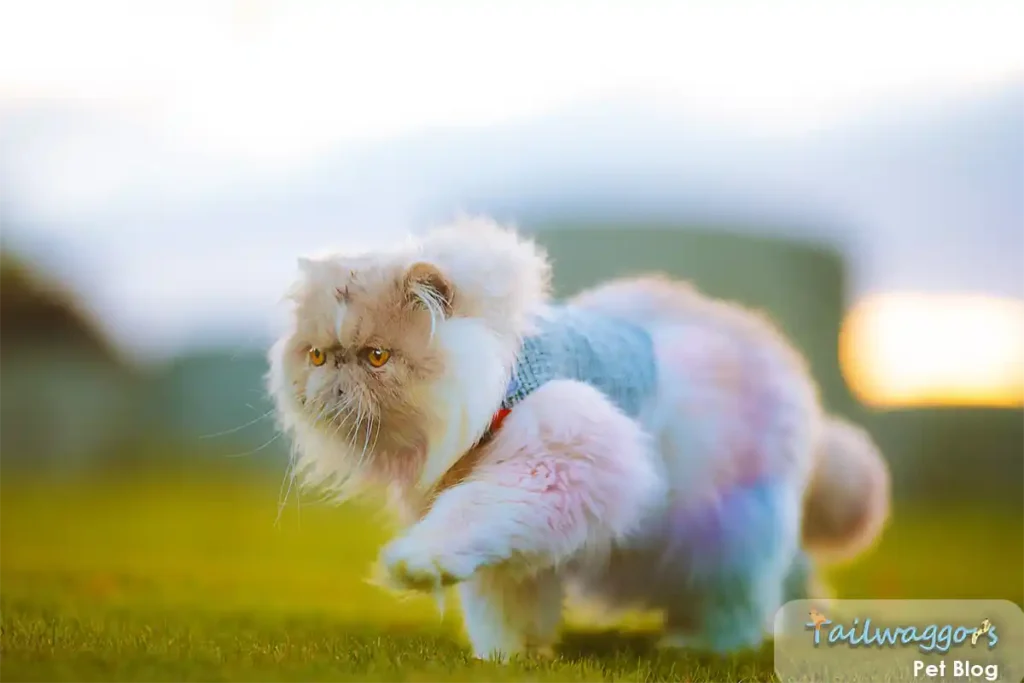
Personality Traits of the Persian Cat
Persian cats are often described as the royalty of the feline world, and their personalities reflect this regal reputation. Known for their calm, affectionate, and serene nature, Persian cats are among the most beloved companion breeds. Let’s explore the key traits that define these majestic cats and how they interact with their human families.
Table: Temperament & Behavior Profile
| Behavioral Trait | Characteristic | Training Need | Adaptability Rating |
| Social Interaction | Affectionate but reserved | Low | ⭐⭐⭐⭐ |
| Activity Level | Low to moderate | Low | ⭐⭐⭐ |
| Problem Solving | Average | Low | ⭐⭐⭐ |
| Attention Seeking | High | Moderate | ⭐⭐⭐⭐ |
| Independence | Moderate | Low | ⭐⭐⭐⭐ |
Calm and Affectionate Companions
Persian cats are deeply affectionate but maintain a dignified demeanor. They thrive in peaceful environments and often form close bonds with their families. While not overly demanding, they enjoy companionship and physical affection.
Persian cats are ideal for families seeking a calm and loving companion,” says Dr. Esther Knoetze, BSC, BVSc. “Their relaxed nature makes them great for homes with children or seniors.”
Real-Life Example: Persian cat owners often share stories of their pets lounging beside them during quiet evenings or gently purring during brushing sessions. They love attention but in a calm, unintrusive manner that suits a relaxed household.
Low Energy but Playful
Persian cats may be low-energy, but they still have bursts of playfulness, especially when presented with engaging toys. Feather wands, puzzle feeders, and gentle games are excellent ways to keep their minds active without overwhelming their need for calm.
🐱 Training Tip: Use interactive toys to encourage activity in Persian cats, but keep sessions short to suit their lower energy levels.
Real-Life Example: Many Persian cats enjoy a few minutes of batting at a toy or chasing a string, but they quickly return to their favorite resting spot for a nap.
Gentle and Tolerant with Children and Pets
One of the standout traits of Persian cats is their gentle nature, making them an excellent choice for families with children or multi-pet households. They are known for their patience and ability to adapt to living with dogs or other cats, provided proper introductions are made.
Persian cats are among the most tolerant breeds, but it’s important to teach children to handle them gently,” advises Dr. Esther Knoetze, BSc, BVSc “Their calm demeanor allows them to adapt well to family life.”
Real-Life Example: Persian cats are often described as “peaceful royalty,” gracefully tolerating the antics of children or other pets in the household. They rarely assert dominance, preferring to coexist harmoniously.
Quiet and Expressive Communicators
Unlike more vocal breeds, Persian cats communicate softly. Their gentle purrs and occasional meows are their way of expressing contentment or asking for attention.
🐱 Fun Fact: Persian cats are known for their expressive eyes, which many owners describe as their primary form of communication. A single glance from their round, soulful eyes can convey their mood or needs.
Understanding Persian Cat Personalities
Persian cats embody elegance, serenity, and affection, making them a beloved choice for households of all types. Their calm demeanor and gentle nature blend seamlessly with their affectionate tendencies, ensuring they become treasured companions. Whether you’re a seasoned cat owner or a first-time pet parent, the Persian’s regal charm, quiet disposition, and adaptability will undoubtedly enrich your home with grace and companionship.
If you’re curious about how stress might impact your Persian cat’s calm demeanor, explore our in-depth guide on feline anxiety to understand its causes and effective management strategies

Physical Characteristics of the Persian Cat
Size and Build
Persian cats are medium to large, celebrated for their cobby, sturdy physiques and regal demeanor. Their build emphasizes their majestic and luxurious appearance.
- Average Size:
- Males: 9–14 pounds (4.1–6.4 kg)
- Females: 7–12 pounds (3.2–5.4 kg)
- Notable Features:
- Short legs supporting a compact body, creating a balanced, poised look.
- A broad chest and wide shoulders that add to their dignified posture.
🐱 Fun Fact: Persian cats’ iconic round faces and flowing coats have made them a staple in artwork and pop culture for centuries, symbolizing luxury and elegance
Coat and Colors
Coat Texture:
- Persian cats have long, luxurious fur that requires daily grooming to prevent matting and maintain its softness.
Common Persian Cat Color Varieties and Specific Care Needs
- White:
- Prone to tear stains; clean daily with a vet-approved solution.
- Use whitening shampoos for a bright, clean coat.
- Black:
- Regular brushing enhances their glossy appearance.
- Avoid prolonged sun exposure to prevent reddish tinting.
- Silver/Golden:
- Requires daily grooming to prevent tangles.
- Brightening shampoos with chamomile or aloe vera help enhance their luster.
- Himalayan (Color-Point):
- Clean stain-prone areas like the paws and face regularly.
- Spot cleaning preserves the contrast of their color points.
- Tabby:
- Weekly brushing helps prevent shedding and preserves pattern clarity.
- Calico/Bi-Color:
- Focus on cleaning white areas to prevent discoloration.
- Pay extra attention to areas where colors meet, as they are prone to tangling.
Facial Features
Persian cats are celebrated for their iconic brachycephalic appearance, making them one of the most sought-after breeds. Their facial structure includes:
- Eyes: Large, round, and wide-set, their expressive gaze is both captivating and calming. Eye colors range from brilliant copper to emerald green, often correlating with their coat color.
- Ears: Small and rounded, set low on their head, adding to their dignified and serene look.
- Nose: Short and flat, with a well-defined “stop” that contributes to their unique, doll-like appearance.
🐱 Fun Fact: Persian cats’ serene expressions and luxurious coats have earned them a place as a symbol of elegance, appearing in countless paintings and films throughout history.
Persian cats’ brachycephalic features make them prone to respiratory challenges and tear staining,” says Dr. Esther Knoetze, BSc, BVSc. “To keep them healthy, regular tear cleaning and monitoring for breathing difficulties are crucial. Additionally, air purifiers can improve their indoor air quality.”
Care Tip: Use a soft cloth or pet-safe wipes to gently clean tear stains daily, and ensure your Persian’s environment is free from allergens or irritants.
Why Understanding These Characteristics Matters
Persian cats’ distinctive physical traits, from their luxurious, flowing coats to their adorable flat faces, make them one of the most iconic and cherished breeds. With proper grooming tailored to their dense fur and attention to their unique needs, Persian cats can thrive in a caring and attentive home. Whether it’s their regal appearance or their enchanting, expressive eyes, Persians are sure to leave an unforgettable impression on anyone who meets them.
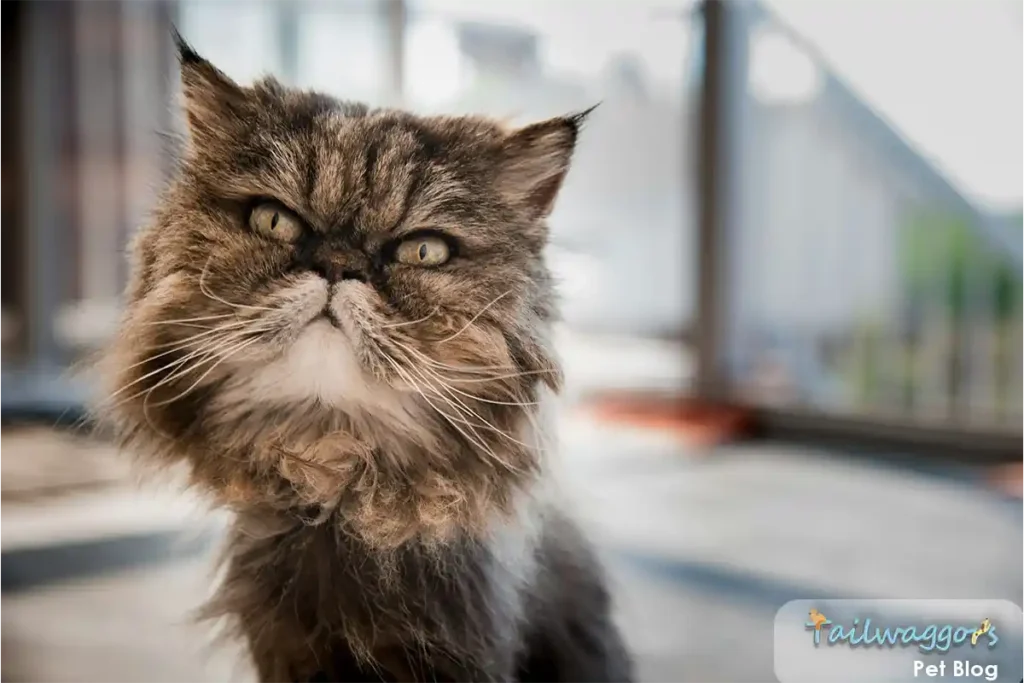
Health and Lifespan of the Persian Cat
Persian cats are renowned for their longevity and serene demeanor, but like all breeds, they are predisposed to certain health challenges. Understanding these potential concerns and implementing preventative measures can ensure your Persian cat leads a long, healthy, and happy life.
Average Lifespan of Persian Cats
Persian cats typically live 12–15 years, with some living even longer when provided with proper care. Their lifespan is influenced by factors such as genetics, diet, and routine veterinary care. Maintaining a healthy weight and providing a stress-free environment are particularly important for this breed, as their physical traits can predispose them to certain conditions.
Real-Life Example: Many Persian cat owners share stories of their pets thriving well into their senior years with attentive care, such as regular vet visits, a kidney-friendly diet, and consistent grooming. One Persian cat in California was reported to have lived 19 years due to a combination of proactive health monitoring and a loving home environment.
Common Health Issues in Persian Cats
Despite their generally calm demeanor, Persian cats are prone to several health conditions due to their unique physical traits. With regular screenings and preventative care, many of these issues can be managed effectively.
Table: Health & Genetic Considerations
| Health Aspect | Risk Level | Prevention Options | Management Rating |
| Brachycephalic Respiratory Syndrome | High | Avoid overexertion, provide a cool, calm environment | ⭐⭐⭐ |
| Polycystic Kidney Disease (PKD) | Moderate | Genetic testing, regular kidney function screenings | ⭐⭐⭐⭐ |
| Dental Disease | Moderate | Routine brushing, dental treats | ⭐⭐⭐⭐ |
| Eye Conditions | High | Daily cleaning, monitor for irritation | ⭐⭐⭐⭐ |
| Obesity | Moderate | Portion control, regular exercise | ⭐⭐⭐ |
Brachycephalic Respiratory Syndrome
- What is it? This condition is caused by the Persian cat’s flat-faced (brachycephalic) structure, leading to narrowed airways and difficulty breathing.
- Symptoms: Labored breathing, snoring, or frequent nasal discharge.
- Prevention and Management: Avoid exposing your Persian cat to extreme heat or overexertion. Provide a cool, quiet environment, and consult a veterinarian for specialized care if symptoms worsen.
Polycystic Kidney Disease (PKD)
- What is it? PKD is a genetic condition in which fluid-filled cysts form in the kidneys, potentially impairing their function over time.
- Symptoms: Increased thirst, frequent urination, weight loss, and lethargy.
- Prevention and Management: Genetic testing is available to identify cats predisposed to PKD. Regular kidney function tests and a low-phosphorus diet can help manage the condition.
Dental Disease
- What is it? Persian cats are prone to tartar buildup and gingivitis, which can lead to more severe dental issues.
- Prevention and Management: Regular brushing and offering dental treats can prevent plaque buildup. Annual dental cleanings at the vet are also recommended.
Eye Conditions
- What is it? Due to their large, prominent eyes, Persian cats are susceptible to tear staining, infections, and irritation.
- Symptoms: Watery eyes, discoloration, or redness around the eye area.
- Prevention and Management: Clean your cat’s eyes daily with a vet-approved solution and monitor for signs of infection.
Obesity
- What is it? Overfeeding and lack of activity can lead to obesity, which increases the risk of diabetes and joint problems.
- Prevention and Management: Ensure portion control and engage your Persian cat with low-impact play sessions, such as using feather wands or interactive toys.
Proactive Care Checklist for Persian Cats
Table: Health Checklist for Persian Cats
| Health Aspect | Recommended Action | Frequency |
| Respiratory Health | Monitor breathing; provide a cool environment. | As needed |
| Kidney Function (PKD) | Genetic testing and regular bloodwork. | Annually |
| Dental Care | Brush teeth; offer dental treats; vet cleaning. | Weekly/Annually |
| Eye Care | Clean tear stains with vet-approved solution. | Daily |
| Weight Monitoring | Adjust food portions; encourage activity. | Monthly |
| Vaccinations | Ensure core vaccines are up to date. | Per vet’s schedule |
| Parasite Prevention | Apply flea and tick preventatives. | Monthly |
| Joint Health | Provide joint supplements if needed. | As recommended |
Regular veterinary care is essential to keeping Persian cats healthy and managing potential breed-specific conditions.
- Dental Care: Brush your Persian cat’s teeth weekly and offer dental chews to reduce plaque buildup. Annual professional cleanings are advised.
- Parasite Prevention: Monthly treatments for fleas, ticks, and worms are essential to avoid discomfort and illness.
- Weight Management: Monitor your cat’s body condition regularly and adjust portion sizes to maintain a healthy weight.
- Vaccinations: Ensure your Persian cat is up-to-date on core vaccines, including feline distemper and rabies.
Signs of Illness to Watch For in Persian Cats
Early detection is critical to managing health conditions effectively. Contact your veterinarian if you notice:
- Persistent coughing, snoring, or nasal discharge (may indicate respiratory issues).
- Increased thirst or urination (potential sign of PKD or diabetes).
- Red, watery, or irritated eyes (could signal an infection or tear staining).
- Weight gain or reluctance to move (may indicate obesity or arthritis).
Persian Cats, like all cats, require regular health checkups. If you’re concerned about health risks for your cat, be sure to explore our Complete Cat Emergency Plan Guide for tips on how to handle emergencies.”
Real-Life Success Story:
A Persian cat in Florida, diagnosed with PKD during a routine checkup, thrived for years with proactive care. The owner provided a low-phosphorus diet, regular vet visits, and plenty of affection. By addressing the condition early, the cat lived a happy, comfortable life well into its senior years.
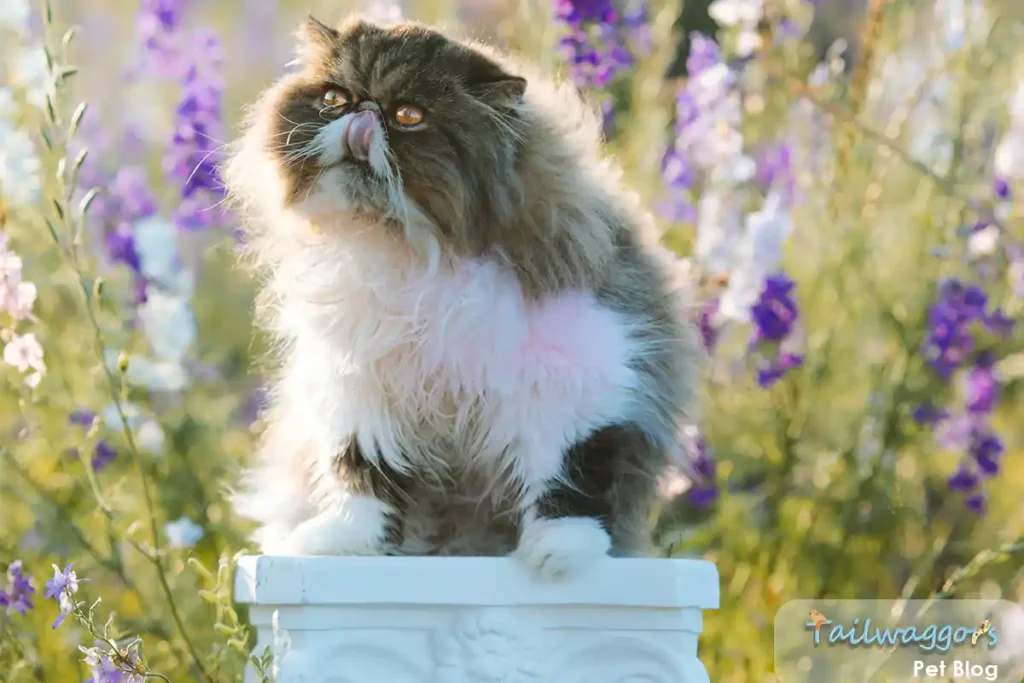
Caring for a Persian Cat: Grooming, Diet, and Maintenance Guide
Persian cats are renowned for their majestic appearance and serene temperament, but their beauty and health come with specific care requirements. From daily grooming to tailored nutrition and regular vet checkups, ensuring your Persian cat thrives requires dedication. Here’s everything you need to know to keep your Persian cat healthy, happy, and looking their best.
Table: Care Requirements
| Care Aspect | Requirement Level | Frequency | Detail | Importance Rating |
| Grooming | High | Daily | Brushing, tear stain cleaning, nail trimming | ⭐⭐⭐⭐⭐ |
| Feeding | High | Daily | High-protein diet, portion control | ⭐⭐⭐⭐⭐ |
| Exercise | Low to moderate | Daily | Interactive toys, gentle play | ⭐⭐⭐ |
| Health Monitoring | High | Annual | Checkups, vaccinations, genetic testing | ⭐⭐⭐⭐⭐ |
Grooming Persian Cats: Tips for Maintaining Their Luxurious Coat
Persian cats’ long, silky coats require consistent care to prevent tangles, mats, and skin issues. Grooming is not just about aesthetics; it also promotes overall health and strengthens the bond between you and your cat.
Daily Grooming Routine
- Brushing: Use a wide-tooth comb for detangling and a slicker brush to remove loose hair. Daily brushing prevents matting and reduces shedding.
- Tear Stain Cleaning: Flat-faced breeds like Persian cats are prone to tear staining. Clean their eyes daily using a vet-recommended tear stain remover or a damp cotton pad.
- Bathing: Bathing every 6–8 weeks helps keep their coat shiny and free of excess oil. Use a cat-safe shampoo designed for long-haired breeds.
Daily brushing not only keeps Persian cats’ coats tangle-free but also prevents skin infections caused by trapped debris,” advises Dr. Esther Knoetze, BSc, BVSc.
Real-Life Example: A Persian cat owner from New York shared how incorporating treats during grooming made the routine enjoyable for both cat and owner. Positive reinforcement can transform grooming into a bonding experience.
Nutrition: Feeding Persian Cats for Health and Longevity
A balanced, high-quality diet is crucial for Persian cats to maintain their health and luxurious coat. Tailoring their nutrition to their specific needs can prevent common health issues like obesity and kidney problems.
Feeding Tips
- Protein-Rich Diet: Choose premium cat food with real meat as the first ingredient. Avoid fillers like corn and soy.
- Portion Control: Measure food based on the feeding guidelines provided by your vet or food manufacturer to prevent overeating.
- Hydration: Persian cats are prone to kidney issues, so ensure they always have fresh water available. Consider a water fountain to encourage hydration.
Special Dietary Considerations:
- Omega Fatty Acids: Foods enriched with omega-3 and omega-6 fatty acids can improve coat shine and skin health.
- Kidney Health: For cats at risk of Polycystic Kidney Disease (PKD), consult your vet about specialized kidney-friendly diets.
A diet high in animal protein supports muscle mass and coat health in Persian cats,” says Dr. Esther Knoetze, BSc, BVSc.
To learn more about keeping your Persian cat safe from potential dietary hazards, check out our Complete Guide to Prevent Cat Poisonings. This guide provides essential tips on identifying dangerous substances and creating a toxin-free environment for your feline friend.
Gentle Exercise for Persian Cats
Persian cats are a low-energy breed, but daily play is still essential to maintain their weight and mental stimulation.
Exercise Needs
- Interactive Play: Feather wands, laser pointers, and small ball toys are perfect for encouraging gentle activity. Aim for 10–15 minutes of play daily.
- Low-Impact Toys: Puzzle feeders or toys that stimulate their hunting instincts provide enrichment without overexertion.
Real-Life Example: A Persian cat owner built a window perch for their cat to enjoy quiet observation of birds and outdoor scenery, offering mental stimulation without physical strain.
Mental Stimulation: Engaging Their Intelligence
Persian cats may have a calm disposition, but mental stimulation is essential for keeping them engaged and happy. Without sufficient enrichment, they can become withdrawn or uninterested in their surroundings.
Enrichment Ideas:
- Interactive Grooming Sessions: Turn grooming into a bonding activity. Use gentle brushes and tools that stimulate their skin while keeping their luxurious coat healthy.
- Puzzle Feeders for Calm Cats: Encourage curiosity and problem-solving by hiding treats in puzzle toys, specially designed for less active breeds like Persians.
- Toy Rotation: Prevent boredom by rotating their toys weekly to reignite interest and keep them entertained.
- Window Watching: Set up a window perch with a view of birds or outdoor activity to cater to their natural curiosity.
Persian cats thrive on low-energy yet engaging activities like gentle grooming and puzzle feeders,” says Dr. Esther Knoetze, BSc, BVSc. “These not only stimulate their minds but also enhance their overall well-being.”
Creating a Comfortable Environment
Persian cats flourish in calm, predictable spaces where they can relax and feel secure. Providing a serene and comfortable environment is key to their happiness.
Cozy Beds and Blankets: Choose soft, plush bedding for your Persian cat and place it in quiet, low-traffic areas.
Safe Hiding Spots: Equip your home with cat caves or enclosed spaces to give your Persian a retreat during stressful events, like loud noises or introductions to new pets.
Temperature Regulation: Their thick coats make them susceptible to overheating. Ensure access to cool areas in the summer and warm, cozy spots during colder months.
🐾 Tailwaggors Tip:
For a full checklist of bedding, toys, and grooming essentials, explore our Vet-Approved New Cat Supply Checklist
Why Proper Care Matters
Persian cats are gentle, affectionate companions who flourish with attentive care. By prioritizing their grooming, nutrition, and mental enrichment, you can help your Persian thrive in a happy, healthy, and serene environment that complements their calm demeanor.
🐾 Tailwaggors Tip:
Dedicate time to bond with your Persian cat through daily grooming or interactive play tailored to their needs. The love and care you invest will be rewarded with their unwavering companionship and regal charm.
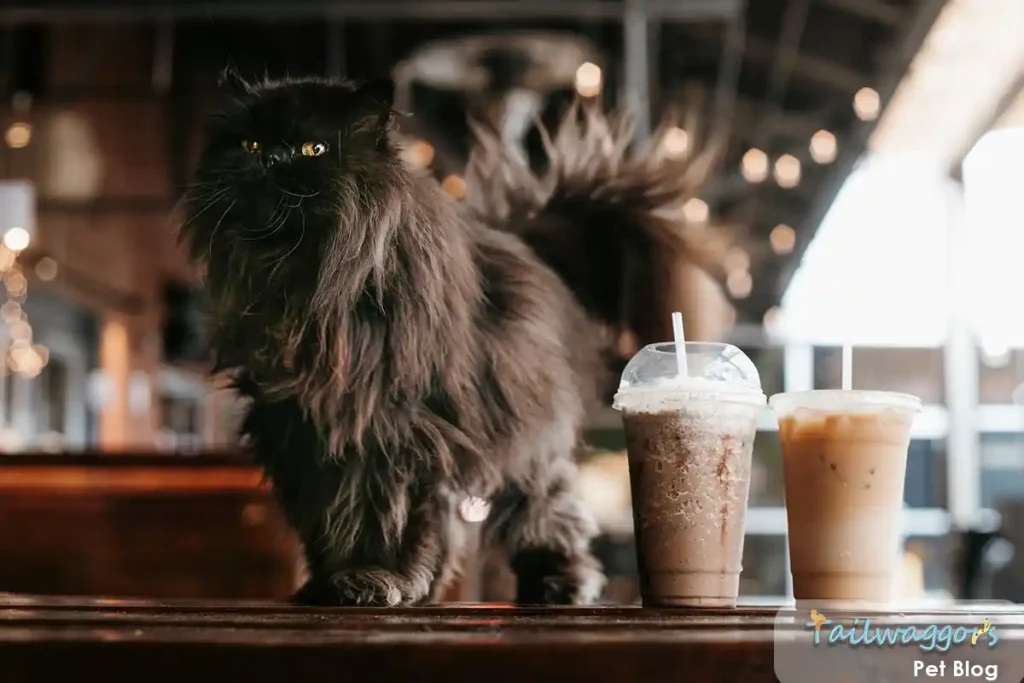
Owning a Persian Cat: Budgeting and Financial Insights
Persian cats are a regal and serene breed, but owning one requires careful financial planning. From their meticulous grooming needs to breed-specific health considerations, Persian cats often come with higher costs than many other breeds. Below is a detailed breakdown of initial expenses, ongoing costs, and strategies to manage these commitments, ensuring your Persian cat receives the best care possible.
Table: Cost Breakdown Analysis Estimates
| Expense Category | Initial Cost | Annual Cost | Value Rating |
| Adoption or Purchase | $500–$5,000 | N/A | ⭐⭐⭐⭐⭐ |
| Food and Treats | N/A | $180–$600 | ⭐⭐⭐⭐⭐ |
| Litter and Maintenance | $30–$100 | $180–$360 | ⭐⭐⭐⭐ |
| Veterinary Care | $150–$500 | $500–$1,500 | ⭐⭐⭐⭐⭐ |
| Grooming Supplies | $10–$100 | $50–$600 | ⭐⭐⭐⭐ |
| Pet Insurance | $240–$600 annually | $240–$600 | ⭐⭐⭐⭐ |
| Miscellaneous (Toys, Scratchers) | $50–$300 | $50–$250 | ⭐⭐⭐ |
| Emergency Care | $200–$5,000 | $0–$300 (if insured) | ⭐⭐⭐⭐ |
Initial Costs: Bringing Your Persian Cat Home
Adoption vs. Breeder Costs
- Adoption Costs: $75–$500
- Includes vaccinations, spaying/neutering, and health checks. Shelters are an affordable option for those seeking a Persian cat without specific pedigree requirements.
- Breeder Costs: $1,000–$5,000
- Reputable breeders provide health guarantees, genetic testing, and detailed lineage records. Show-quality Persian cats or rare coat colors, such as silver or chinchilla, command higher prices.
Essential Supplies
Preparing for your Persian cat’s arrival involves purchasing several essential items:
| Item | Cost Range |
| Litter Box | $15–$50 |
| Cat Litter | $15–$25 per bag |
| Food and Water Bowls | $10–$30 |
| Scratching Posts | $20–$100 |
| Cat Carrier | $25–$75 |
| Toys | $15–$30 |
| Grooming Tools | $10–$100 |
| Cat Bed | $20–$150 |
Total Setup Cost: $150–$500
Providing high-quality grooming tools is essential for Persian cats due to their dense, long coats,” says Dr. Esther Knoetze, BSc, BVSc. “This minimizes matting and improves skin health.”
Ongoing Annual Costs
Food and Nutrition
Persian cats require a high-quality, protein-rich diet to maintain their health and glossy coats.
| Food Type | Cost Range (Annually) |
| Dry Food | $180–$300 |
| Wet Food (Optional) | $300–$600 |
| Specialty Foods (if needed) | $400–$800 |
Tip: Consult your veterinarian for dietary recommendations tailored to your cat’s age and health status.
Veterinary Care
Routine vet visits are crucial for Persian cats, given their predisposition to certain health conditions.
| Category | Cost Range (Annually) |
| Wellness Checkups | $100–$500 |
| Vaccinations | $50–$130 |
| Dental Cleaning | $200–$800 |
| Flea/Tick Prevention | $60–$150 |
Regular dental cleanings are especially important for Persian cats, as their flat-faced structure can lead to overcrowding and plaque buildup,” explains Dr. Esther Knoetze, BSc, BVSc.
Grooming Expenses
Persian cats’ long, luxurious coats demand daily grooming, either done at home or by professionals.
| Type | Cost Range |
| At-Home Grooming Supplies | $50–$100 annually |
| Professional Grooming | $50–$100 per session |
Hidden Costs: Things You Might Not Expect
- Emergency Medical Expenses: Advanced diagnostics and treatments for conditions like Polycystic Kidney Disease (PKD) can cost $1,000–$5,000.
- Pet Insurance: Monthly premiums of $20–$50 can offset significant veterinary expenses.
- Travel-Related Costs: Boarding fees or pet-sitting services average $25–$50 per day.
Is Owning a Persian Cat Worth the Investment?
Owning a Persian cat comes with unique responsibilities, but the rewards far outweigh the costs. These gentle and affectionate companions bring elegance and tranquility to any household. By budgeting for their grooming, healthcare, and daily needs, you’ll ensure your Persian cat leads a happy and comfortable life. Here are a few tips to manage your budget:
- DIY Grooming: Learn basic grooming techniques to reduce reliance on professional services.
- Preventive Care: Regular vet visits can help detect issues early, reducing the likelihood of expensive emergency treatments.
- Bulk Purchasing: Stock up on supplies like cat litter and food during sales for cost savings.
Real-Life Example: A Persian cat owner noted that investing in pet insurance saved them thousands in emergency care costs when their cat developed PKD symptoms.
Understanding the “10 Things to Consider Before Bringing a New Pet Home” can help you prepare for the financial and emotional commitment of owning a Persian cat.
Persian cats require dedicated grooming and regular healthcare to thrive. Owners who prioritize their long-haired coats, sensitive health needs, and comfortable environments ensure their Persians enjoy a long, healthy, and serene life,” advises Dr. Esther Knoetze, BSc, BVSc.
🐾 Tailwaggors Tip:
Owning a Persian isn’t just an expense—it’s an investment in a graceful and loving companion. With thoughtful planning, your Persian will fill your home with charm and warmth for years to come.
Disclaimer:
The cost estimates provided in the “Persian: Budgeting and Financial Insights” section are general approximations based on current market trends and commonly reported expenses in the United States. Actual costs may vary depending on factors such as location, individual pet needs, specific health conditions, and lifestyle choices.
These estimates are intended for informational purposes only and should not replace personal research or consultations with veterinary or pet care professionals. We recommend setting aside additional funds for unexpected expenses, including emergency veterinary care and specialized dietary or training needs, to ensure your Alaskan Malamute receives the best possible care.
Always consult with a veterinarian or trusted breeder for detailed guidance tailored to your specific situation. Tailwaggors is not responsible for discrepancies or unforeseen costs that may arise.
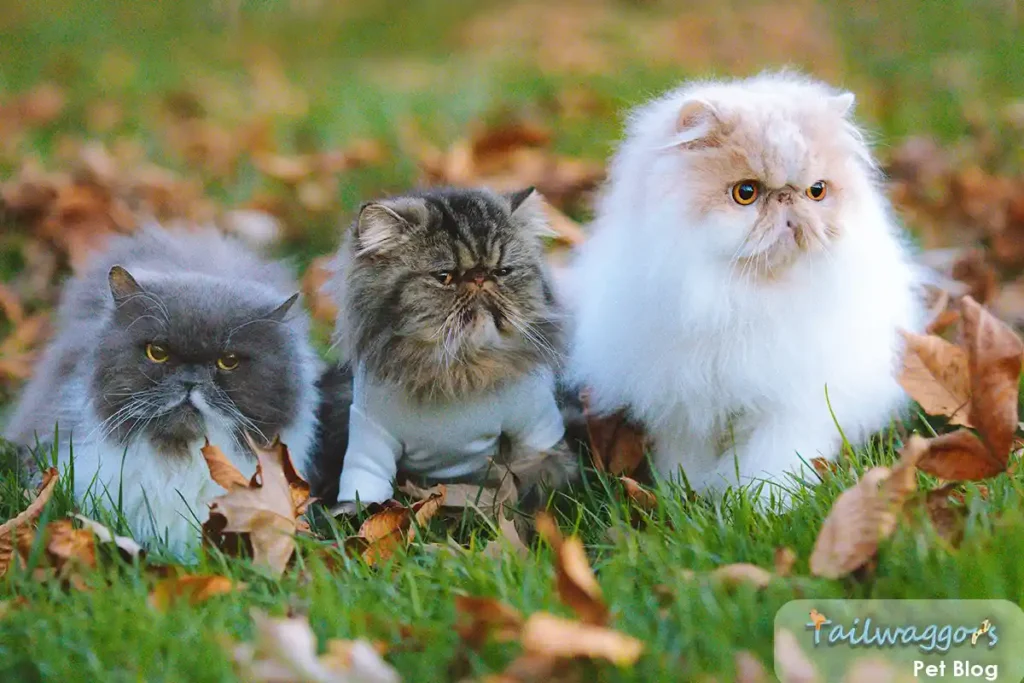
Breed Comparison: Persian vs. Other Popular Breeds
When considering adding a Persian cat to your family, it’s helpful to compare them with other popular breeds to determine which is the best fit for your lifestyle. Persian cats stand out for their luxurious coats, calm demeanor, and affectionate nature, but how do they compare to breeds like the Maine Coon, Ragdoll, and Siamese? This section highlights the key differences and similarities to help you make an informed decision.
Table: Breed Comparison
| Aspect | Persian | Maine Coon | Ragdoll | Siamese | Rating |
| Size | Small to medium (7–12 lbs) | Large (13–18 lbs) | Large (10–20 lbs) | Small to medium (6–14 lbs) | ⭐⭐⭐⭐ |
| Coat | Dense, long, requires daily care | Shaggy, moderate grooming | Silky, low grooming | Short, minimal grooming | ⭐⭐⭐⭐⭐ |
| Personality | Calm, affectionate | Playful, energetic | Laid-back, affectionate | Vocal, social | ⭐⭐⭐⭐⭐ |
| Grooming Needs | Very high | Moderate to high | Low to moderate | Low | ⭐⭐⭐ |
| Exercise Needs | Low | High | Low to moderate | Moderate to high | ⭐⭐⭐ |
| Energy Level | Low | Very high | Low | High | ⭐⭐⭐⭐⭐ |
| Affection Level | Very high | Very high | Very high | Moderate | ⭐⭐⭐⭐⭐ |
| Compatibility with Pets | Good | Excellent | Excellent | Moderate | ⭐⭐⭐⭐ |
Persian Cat vs. Maine Coon
The Maine Coon is a large, shaggy-coated breed that is significantly more active and energetic than the Persian cat. Both breeds are affectionate, but their care requirements and personalities differ greatly.
Key Differences:
- Size: Persian cats are much smaller than Maine Coons, weighing around 7–12 lbs compared to the Maine Coon’s 13–18 lbs.
- Coat: While both breeds have long coats, Persian cats require daily grooming to prevent matting, whereas the Maine Coon’s shaggy coat needs brushing 2–3 times a week.
- Temperament: Persian cats are calm and enjoy lounging in quiet environments, while Maine Coons are playful, active, and dog-like in their social interactions.
If you prefer a relaxed, low-energy companion, the Persian cat is a better choice. However, for families who want an active, outgoing pet, the Maine Coon may be a better fit.
Persian Cat vs. Ragdoll
Both Persian cats and Ragdolls are affectionate and laid-back, but their grooming needs and personalities differ slightly, making each breed unique.
Key Differences:
- Size: Ragdolls are larger, weighing between 10–20 lbs, while Persians are typically 7–12 lbs.
- Coat: Ragdolls have a silky, semi-long coat that requires light grooming 1–2 times a week. Persian cats, on the other hand, have dense, long fur that needs daily care to prevent tangles and matting.
- Temperament: Ragdolls are known for going limp when picked up and being lap cats. While Persians are equally affectionate, they are less likely to demand attention and prefer a quiet spot to lounge.
Ragdolls are perfect for owners who want a larger, low-maintenance lap cat, while Persian cats are ideal for those who enjoy the bonding experience of regular grooming.
Persian Cat vs. Siamese
Siamese cats are the polar opposite of Persian cats in many ways, from their vocal and energetic personalities to their low-maintenance coats.
Key Differences:
- Energy Level: Siamese cats are highly active and enjoy climbing, playing, and exploring their environment. Persian cats are low-energy and prefer a peaceful, relaxed home.
- Coat: Siamese cats have short, sleek coats that require minimal grooming, while Persian cats need daily brushing and regular eye cleaning.
- Personality: Siamese cats are vocal and demand constant attention, often following their owners around and “talking” to them. Persian cats are more reserved but equally affectionate in their own quiet way.
Siamese cats are great for active households that enjoy a talkative, playful companion, while Persian cats suit calm homes looking for a serene and affectionate presence.
Why Choose the Persian Cat?
Each breed has its unique charm, but Persian cats are perfect for those who value calm, affectionate companionship and are prepared to dedicate time to grooming and care. If you’re still undecided, explore our Complete Guide to Choosing the Right Cat Breed for more comparisons and insights.
Persian cats are ideal for families seeking a gentle and loving pet. Their luxurious coats require consistent grooming, and their relaxed nature thrives in peaceful, predictable environments. To ensure their well-being, prioritize routine grooming, high-quality nutrition, and regular veterinary check-ups,” advises Dr. Esther Knoetze, BSc, BVSc.
🐾 Tailwaggors Tip:
If you’re looking for a calm and affectionate cat that loves serene environments and companionship, the Persian is an excellent choice. With regular grooming, a comfortable home setup, and plenty of love, your Persian will reward you with unparalleled charm and devotion.

Frequently Asked Questions about the Persian Cat
In this section, we’ll address some of the most frequently asked questions about Persian cats, covering their grooming needs, health concerns, and suitability as pets. Whether you’re considering adopting a Persian cat or are already a proud owner, these answers will give you valuable insights into this elegant and loving breed.
Are Persian cats hypoallergenic?
+No, Persian cats are not hypoallergenic. They produce allergens in their skin, saliva, and fur, which can trigger allergic reactions. Their dense coats can also trap allergens such as dust and dander, exacerbating symptoms for sensitive individuals.
🩺 Expert Insight:
“While no cat is truly hypoallergenic, regular grooming and bathing can help reduce allergens. Using an air purifier can also minimize dander in your home.” – Dr. Esther Knoetze, BSc, BVSc
🐾 Pro Tip:
Regular brushing and vacuuming can make it easier for allergy sufferers to coexist with Persian cats.
How much do Persian cats weigh?
+Persian cats typically weigh:
- Males: 10–14 pounds (4.5–6.3 kg)
- Females: 8–12 pounds (3.6–5.4 kg)
Despite their moderate weight, their dense coats create an impression of grandeur.
💡 Fun Fact:
Persian cats’ compact frames and luxurious fur contribute to their iconic image as “living works of art.”
How long do Persian cats live?
+Persian cats have an average lifespan of 12–15 years, though some can live into their late teens with proper care. Factors such as genetics, diet, and regular veterinary visits play a significant role in their longevity.
🐾 Pro Tip:
Schedule annual checkups and monitor for common health issues like Polycystic Kidney Disease (PKD) to ensure early intervention and a longer, healthier life.
Are Persian cats good with children and pets?
+Yes, Persian cats are gentle and patient, making them excellent companions for children and other pets. They adapt well to calm households and tend to get along with well-behaved dogs or cats.
📝 Real-Life Example:
A Persian cat owner in Texas shared that their Persian cat bonded closely with their toddler, often curling up beside them during storytime.
Do Persian cats need daily grooming?
+Yes, daily grooming is essential to prevent tangles, matting, and tear stains. Grooming also keeps their skin healthy and minimizes shedding.
🩺 Expert Insight:
“Daily brushing with a wide-tooth comb and slicker brush can prevent mats and reduce the risk of skin irritation.” – Dr. Esther Knoetze, BSc, BVSc
🐾 Pro Tip:
Make grooming enjoyable for your Persian by starting early and offering treats or praise during sessions.
Are Persian cats prone to health issues?
+Yes, Persian cats are predisposed to specific health conditions:
- Brachycephalic Respiratory Syndrome: Their flat faces can cause breathing difficulties.
- Polycystic Kidney Disease (PKD): A genetic condition affecting kidney function.
- Dental Problems: Their jaw structure makes them prone to tartar buildup and gum disease.
🐾 Pro Tip:
Regular vet checkups, genetic testing, and a tailored diet can help manage these conditions effectively.
How much exercise does a Persian cat need?
+Persian cats are a low-energy breed and require minimal exercise. Gentle play sessions with feather wands or puzzle toys are sufficient to keep them engaged and maintain a healthy weight.
💡 Fun Fact:
Persian cats often enjoy quiet observation, spending hours lounging in sunny spots or perched near a window.
Can Persian cats be kept indoors?
+Yes, Persian cats thrive as indoor pets. Their calm and relaxed nature makes them well-suited for indoor living, where they are protected from outdoor hazards.
🐾 Pro Tip:
Create a cozy indoor environment with scratching posts, comfortable beds, and interactive toys to keep them mentally stimulated.
Persians: The Quintessential Lap Cat
Persian cats are a breed that epitomizes elegance, tranquility, and affection. Their laid-back nature and consistent care needs make them a perfect choice for individuals, families, and even multi-pet households seeking a calm and loving companion.
For essential advice on creating the best environment for your Persian or handling emergencies, explore these must-read guides:
- Prevent Cat Poisonings: Essential Tips and Emergency Advice for Pet Owners
- Vet-Approved New Cat Supply Checklist
🐾 Tailwaggors Tip:
If you’re looking for a calm and affectionate cat that thrives in a serene and predictable environment, the Persian is an excellent choice. With regular grooming, gentle interaction, and plenty of love, your Persian will reward you with devotion and quiet companionship.
Persian cats are ideal for pet owners seeking a gentle and affectionate companion. Their luxurious coats require consistent grooming, and their calm demeanor thrives in low-stress environments. To ensure their well-being, prioritize routine grooming, quality nutrition, and regular veterinary care,” advises Dr. Esther Knoetze, BSc, BVSc.
Conclusion: Wrapping Up the Ultimate Guide to the Persian Cat
Persian cats are iconic companions, celebrated for their luxurious beauty and calm demeanor. Their long, flowing coats and serene personalities bring a sense of elegance to any home, making them one of the most cherished breeds worldwide. Whether you’re a first-time cat parent or a seasoned owner, Persian cats captivate with their gentle charm and devotion.
Providing the Best Care for Persian Cats
To help your Persian cat thrive, understanding their specific care needs is vital. Regular grooming, health monitoring, and creating a stress-free home environment will keep your Persian cat happy and healthy.
- Daily Grooming: Brush their coat daily to prevent matting and clean around their eyes to reduce tear stains.
- Health Management: Schedule regular veterinary checkups to monitor for common breed-specific conditions like Polycystic Kidney Disease (PKD) and respiratory issues.
- Comfortable Environment: Persian cats flourish in calm, predictable settings and thrive on companionship.
“Routine grooming and early detection of health concerns, like PKD, are key to ensuring Persian cats live long and healthy lives,” says Dr. Esther Knoetze, BSc, BVSc.
Thinking of Adopting a Persian Cat?
Adopting a Persian cat is a rewarding experience, but it requires dedication to their unique care needs. With their low-energy nature, Persian cats thrive in serene environments where they can enjoy gentle companionship and routine grooming. In return, they’ll bring unparalleled affection and tranquility to your home.
If you’re considering other breeds, visit our Complete Guide to Choosing the Perfect Cat Breed or explore the unique traits of the Abyssinian Cat.
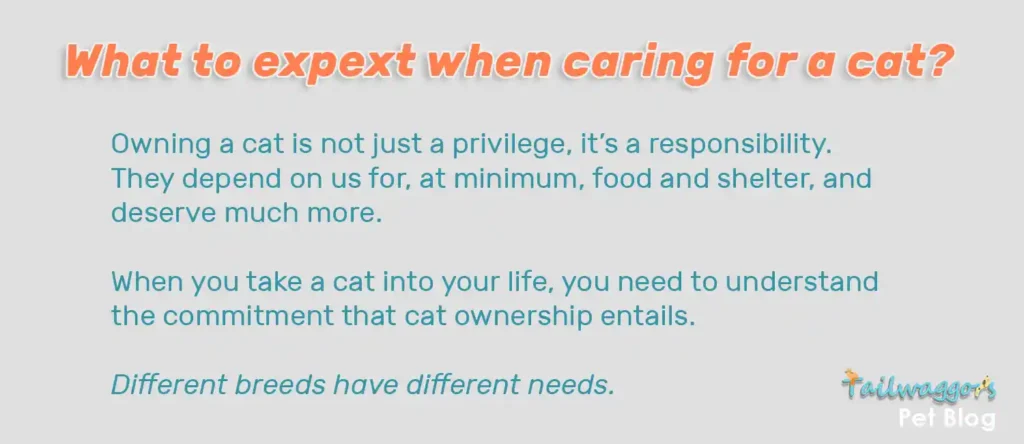
Share Your Persian Story!
We’d love to hear about your experiences with Persian cats! Share your stories, care tips, and funny moments in the comments section below. Don’t forget to connect with us on social media for expert tips, updates, and heartwarming Persian cat stories. Contact Tailwaggors.
Keep the Conversation Going 🐾💫
Persian cats are more than just pets—they’re companions that bring elegance and love into your home. Explore their grooming needs, health tips, and unique traits in this comprehensive guide. Share this with fellow cat lovers, and let’s celebrate the regal beauty of Persian cats together! 🐱❤️


